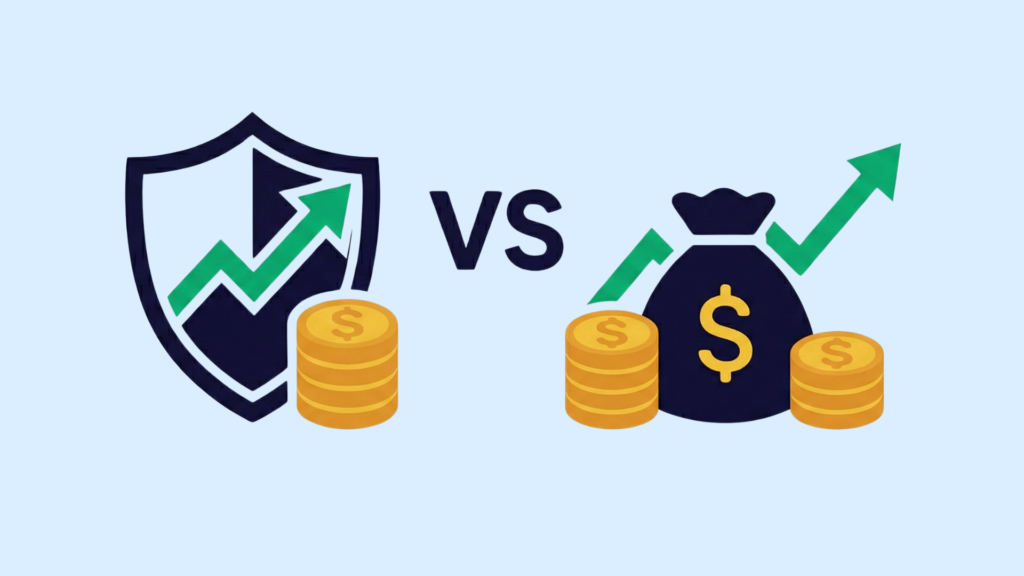The mutual funds market is mainly divided into two types: open-ended and closed-ended mutual funds. Their categorisation is primarily based on their investment flexibility and maturity period.
Open-ended mutual funds are popular among investors because they can be easily traded without restriction. On the other hand, closed-ended mutual funds started gaining popularity because they offer greater long-term opportunities and fluctuating interest rates.
If you are planning to invest in close-ended mutual funds, read on to learn how they work and whether they are the right investment for you.
What Are Closed-Ended Mutual Funds?
Closed-ended mutual funds are debt or equity funds that issue a fixed number of shares during their initial public offering (IPO) for a fixed maturity period. After the initial offering, you can not directly buy or redeem closed-ended funds from the fund. Instead, similar to stocks, you will have to trade them in the secondary market.
Simply put, closed-ended funds enable the fund managers to follow the fund’s investment objectives because they remain closed after their initial launch period until maturity.
Key Characteristics of Closed-Ended Mutual Funds
Key characteristics of closed-ended mutual funds influence how investors buy, sell, and manage their shares. Some of those essential characteristics are:
Fixed Number of Shares
During the IPO, the fund issues a limited number of shares. The fixed number of shares is the main reason for their market-driven price structure.
Listed on the Stock Exchange
Shares can only be listed and traded on the secondary markets, such as stock exchanges, after the IPO. The price of the shares fluctuates according to the market demand and supply.
Leverage Usage
Leverage (borrowed money) in many closed-ended mutual funds increases the potential for both risk and returns.
Maturity Period
Closed-ended mutual funds have a fixed maturity period. Before the end of the lock-in period, investors cannot redeem shares; they can only trade them on the secondary market.
Features of Closed-Ended Mutual Funds
The main features that distinguish closed-ended mutual funds from other types of funds are:
Limited Subscription Period
Investors can subscribe to closed-ended mutual funds only during the NFO (New Fund Offer). After that, no new shares are issued. So, investors who want to invest must buy existing shares from secondary markets like the stock exchange.
Traded on Stock Exchanges
After NFO, the closed-ended mutual funds are only listed and traded on stock exchanges. Investors will need a brokerage account to buy and sell these shares, as with any other publicly offered securities.
Price Fluctuations Based on Market Demand
As opposed to open-ended mutual funds, the price of closed-ended funds is driven by market demand and supply. This means that the shares can be traded at a premium (higher) or discount (lower) price to the NAV, depending on the demand and supply.
Potential for Higher Yields
Most closed-ended mutual funds use leverage and borrow funds to make additional investments. Leverage increases the potential for returns, but it also increases risk because the price is market-driven.
Also Read: Hybrid Mutual Funds | Best trading App | Open Ended Mutual Funds
How Do Closed Ended Mutual Funds Work?
Understanding the process can be complex. Here’s a breakdown of how closed-ended mutual funds operate in the market:
Initial Public Offering (IPO)
During an IPO, the fund raises capital by issuing a fixed number of shares for a set amount of time. After that, no new shares are issued.
Trading on the Stock Exchange
The shares are later published on the stock exchange, where they can be traded according to market demand and supply. Unlike open-ended funds, new shares are not issued in closed-ended funds after the IPO.
Net Asset Value (NAV)
The NAV of closed-ended funds is regularly calculated based on the value of their underlying assets. Moreover, the shares can be traded at a premium or discount to that value as per market conditions.
Distributions and Capital Gains
Like other mutual funds, closed-ended funds also distribute both income and capital gain to their shareholders. However, investors must sell their shares on the stock exchange for realisation.
Closed Ended Funds vs. Open Ended Funds
Here’s what differentiates closed-ended mutual funds from open-ended mutual funds:
Subscription and Redemption
You can invest in closed-ended funds only during the IPO and later trade in the stock exchange. At the same time, you can invest continuously through lump sum or SIPs in open-ended funds and enter or exit the market anytime.
Liquidity
Closed-ended funds offer lower liquidity as they can only be traded on the stock exchange until the mandatory lock-in period. On the other hand, open-ended funds offer high liquidity as investors can buy and sell their shares anytime at the NAV.
Price Determination
The price of open-ended funds is based on the NAV, while the price of closed-ended funds can differ from the NAV because it is market-determined. The market’s demand and supply fluctuations can significantly affect the price of closed-ended mutual funds.
Investment Flexibility
You can make any number of purchases in open-ended mutual funds through lump sum investments or small SIPs. Meanwhile, closed-ended mutual funds only allow lump sum investments during the IPO or NFO (New Fund Offering).
Advantages of Closed-Ended Mutual Funds
There are various benefits of investing in closed-ended mutual funds. Some of those are:
Stable Asset Base
Closed-ended funds provide the fund manager with a good starting point for creating a strategy for achieving the scheme’s investment objective. Since investors can not redeem their units before the maturity period, there’s no redemption pressure. Fund managers worry less about maintaining liquidity and focus more on investing in long-term growth opportunities.
Potential for Higher Returns
Since closed-ended mutual funds are traded like stocks in the share market, they possess a potential for higher returns during favourable market conditions. During an increase in demand for any closed-ended mutual funds scheme, their units can be sold at a higher price than the scheme’s net asset value (NAV).
Professional Management
Professional portfolio managers manage closed-ended mutual funds. Their actions and decisions significantly affect the success of the fund’s scheme. Experienced fund managers evaluate markets in detail to assess risk and maximise returns.
Diversification
Fund managers create strategies and invest the funds in a diversified portfolio of assets. They ensure investment goes to multiple long-term opportunities that reduce the risk of individual securities and diversify the investment portfolio.
Disadvantages of Closed-Ended Mutual Funds
Like any other mutual funds, closed-ended mutual funds also come with potential drawbacks. Some of those are:
Market Volatility
The price of closed-ended funds can be more volatile than that of open-ended funds. Their price is driven by the demand and supply of market conditions, which can fluctuate significantly. This makes them riskier during market instability.
Premiums and Discounts to NAV
Closed-ended funds can be traded to their NAV at a premium or discount value. This means that investors may not always buy or sell the shares at a fair price, which can significantly affect the overall returns.
Less Liquidity
Closed-ended funds offer less liquidity than open-ended funds. Their shares can only be traded on the stock exchange and can not be redeemed before the maturity period.
Higher Risk Due to Leverage
Leverage refers to borrowing money higher than the capital base. Many closed-ended funds use leverage, which can amplify returns and losses according to fluctuating market conditions.
Taxation of Closed-Ended Mutual Funds
Equity and debt funds are taxed differently. In the case of closed-ended mutual funds, the tax rate depends separately on the investment made in debt and equity.
Equity-Oriented Closed Ended Funds
For tax purposes, a fund is treated as an equity fund if it invests 65% of its total assets or more in equity or equity-related instruments.
Long-Term Capital Gains (LTCG): Gains above Rs.1 lakh that are held for more than a year are taxed at a 10% rate.
Short-Term Capital Gains (STCG): Gains held for less than one year are taxed at 15%.
Debt-Oriented Closed Ended Funds
For tax purposes, a fund is treated as a debt fund if it invests at least 65% of its total assets in debt or debt-related instruments.
Long-Term Capital Gains: Gains that are held for more than three years are taxed at 20% with indexation.
Short-Term Capital Gains: Gains are taxed according to the investor’s applicable tax slab after they are added to income.
Who Should Invest in Closed-Ended Mutual Funds?
An ideal investor for investing in closed-ended mutual funds can be:
Long-Term Investors
Investors who can lock their capital for a set period of time. Those who are looking for long-term investment opportunities.
Investors Seeking Higher Returns
Investors who have a capacity for high-risk tolerance and are looking for higher potential returns. They can use the leverage to maximise the returns.
Experienced Investors
Investors who have an understanding of market volatility and leverage. Those who understand the risk that comes with closed-ended mutual funds.
The Bottom Line
In a nutshell, closed-ended mutual funds offer a unique structure and investment opportunities with the potential for higher returns. However, if you have made it this far, you are aware of the potential risks, such as leverage, market-driven price, and fixed maturity period. It is always advisable to consider your investment horizons and assess your risk tolerance before investing in any type of mutual fund.
At Appreciate Wealth, we strive to improve financial literacy and wealth creation for our clients. We bring you a variety of unique investment options like mutual funds, US stocks, fractions, etc. All you have to do is open your account today and get started.
Closed-ended Mutual Funds FAQs:
Q1. What are closed-ended mutual funds?
Closed-ended mutual funds are types of funds that issue a fixed number of shares during the IPO with a fixed maturity period. After that, the shares can only be traded in the secondary market, and no new shares are issued.
Q2. How do closed-ended mutual funds work?
After the IPO, closed-ended funds are listed and traded on the stock market. If investors wish to redeem their shares before the maturity period, they must sell their shares to other investors on the stock market. Once the maturity period is over, capital gains and dividends are distributed to stakeholders, and investors are paid based on the value of underlying assets.
Q3. What is the difference between closed-ended and open-ended mutual funds?
Closed-ended mutual funds are distinguished from open-ended mutual funds by their fixed number of shares, maturity period, and market-driven price.
Q4. Can I sell closed-ended mutual fund shares before maturity?
Yes, you can trade your closed-ended mutual funds before the maturity period on the secondary market, such as the stock exchange. However, depending on market demand and supply, the selling price can be at a premium or discount.
Q5. How are closed-ended funds taxed?
Closed-ended mutual funds are also taxed like any other mutual funds. The specific tax rates are based on local regulations, investment in debt and equity, the investor’s tax slab, and the length of the investment period.
Q6. What are the risks of investing in closed-ended mutual funds?
Major risks involved with investing in closed-ended mutual funds are the use of leverage (borrowed money), liquidity limitation, market volatility, and market-driven prices.
Q7. Why do closed-ended funds trade at a premium or discount to NAV?
Due to the fixed number of shares, the price of closed-ended funds is dependent on the market’s demand and supply. As the market’s demand and supply fluctuate, the value can fluctuate as a premium or discount to NAV.
Q8. What are the advantages of closed-ended mutual funds?
The advantages of closed-ended mutual funds are focusing on long-term investment opportunities, stable capital, use of leverage, potential for higher returns, and liquidity of shares.
Q9. Are closed-ended funds suitable for long-term investors?
Closed-ended mutual funds are highly suitable for long-term investors. Their unique structure makes them suitable for investors looking for long-term income and growth opportunities.
Q10. How can I invest in closed-ended mutual funds?
You can buy the shares directly from the IPO or trade them on the stock market later. You will need a brokerage account if you want to sell or buy shares on the stock exchange.
Q11. Do closed-ended mutual funds use leverage?
Yes, closed-ended mutual funds use leverage (borrowed money) to increase their potential returns. However, because the price is market-driven, the use of leverage can also increase the potential risk.
Q12. What happens when a closed-ended fund reaches maturity?
Typically, once the maturity period is completed for closed-ended mutual funds, the portfolio is liquidated, and the proceedings are distributed to the stakeholders. Investors are paid on the value of underlying assets. Additionally, some funds can be converted to open-ended structures or other types of investments.
| Read more Articles by Appreciate: | |
Disclaimer: Investments in securities markets are subject to market risks. Read all the related documents carefully before investing. The securities quoted are exemplary and are not recommendatory.























